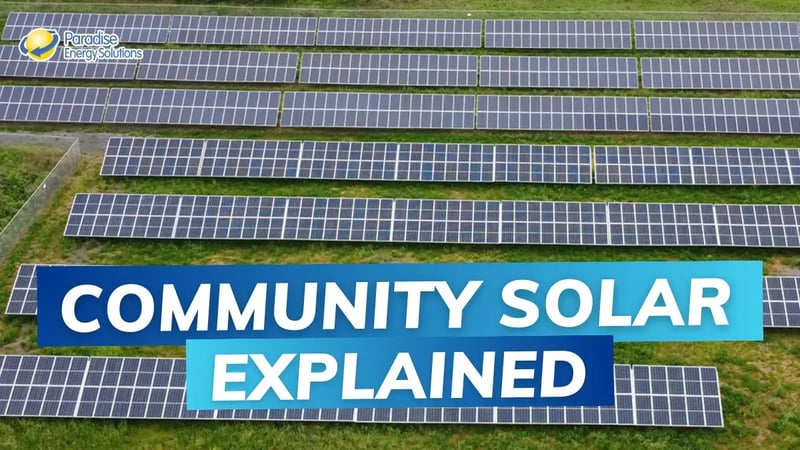Community Solar Explained: How It Works and Who It's For

There is more than one way for someone to take advantage of solar energy’s environmental benefits. Depending on the goals of the project, you can either purchase or lease a solar system on your property or participate in a community solar project.
If installing a solar energy system on your property isn’t an option, participating in a community solar program could provide you with the clean energy alternative that you’re looking for. But as with everything, there are pros and cons that you need to be aware of.
Paradise Energy Solutions does not currently participate in community solar programs, but we believe in helping everyone be good stewards of God’s abundant resources. That’s why it’s important that you’re aware of all your options, including community solar.
What is Community Solar? A Comprehensive Overview
Community solar, or shared solar, is when the energy produced from a local solar system or facility is shared by community members. The solar systems are typically built on public or jointly owned land, and the energy is made available to community members through two models: community solar ownership or community solar subscription.
Community solar ownership is when the community member purchases a portion of panels on the system. The number of panels will depend on the owner's annual energy usage, covering up to 100% of their annual energy usage. You would still receive the SRECs and 30% Federal Tax Credit since you own a portion of the system. This model tends to be more difficult to organize and maintain. It can also be a barrier of entry for people who can’t afford the upfront cost.
Pros of Ownership Community Solar:
- Many of the benefits of owning a solar system are still available to you
- You're making a positive environmental impact
Cons of Ownership Community Solar:
- The ownership model can be difficult to organize and maintain
- It can be expensive
- Community solar is not available in all areas
Another method to participate with community solar is the subscription method. This is when a third party will develop and own a system that you’ll purchase power from. You will be charged an agreed-upon rate for the power plus administrative fees. Enrollment and billing are handled by the third party or involved utility.
Pros of Community Solar - Subscription Model:
- It's a cheaper way to take advantage of the environmental benefits of solar
- The kWh price is usually lower than other available rates
- Typically easy to opt-in and out
Cons of Community Solar - Subscription Model:
- You won't have access to any of the tax benefits of solar
- You don't own anything
- There will be administrative costs
- Community solar is not available in all areas
In both scenarios, the produced energy is credited to you through Virtual Net Metering (VNM).
Ideal Candidates for Community Solar Participation
Community solar makes solar energy available for many who may not otherwise have the means to go solar, whether that’s financial or space deficiencies.
These are the scenarios that make sense for involvement in community solar:
- Your property has obstacles that are less than ideal for a solar system - i.e. shade, spacing, roof orientation, etc.
- You don’t own your home or building
- A move is in your near future
- You live in a townhouse or multi-tenant facility
- You can’t afford your own solar system - Here’s a good look at what it cost to go solar
How A Typical Community Solar Setup Works
The typical community solar setup can be shown in five simple (on paper) steps:
-
A group of people or a third-party organization decides to build a centralized solar system
-
The builder of the system will seek out subscribers or owners
-
The subscriber or owner gets a portion of the system's production allocated to them
-
This electric production goes directly to the utility company. A credit will then be applied to your bill through a process called Virtual Net Metering (VNM)
-
You turn on your lights and use up the electricity that is credited to you
How Does Community Solar Compare To Installing Solar At Your Home?
There are a few other options available if community solar doesn’t fit your goals and objectives. Those options include solar ownership or leasing a system.
Solar system ownership is when the complete upfront system cost is paid for by the property owner. The property owner takes full ownership of the system after installation is complete, including maintenance and repairs (outside of any warranties). However, the owner also owns all of the financial incentives, like the Federal Tax Credit and cost reductions.
Solar leasing is when a third party installs a solar system on your property with no upfront cost to the property owner. The property owner then purchases the electricity from the system for an agreed-upon price. All the tax benefits would belong to the company that owns the system.
Pros of Solar Ownership:
- You'll get all the financial benefits of going solar, including the tax credits, SREC income (where available), and free electricity
- You'll own a tangible asset that will increase your property value
- Installing a solar system on your property is possible just about everywhere. Community solar is only allowed in some states and municipalities
Cons of Solar Ownership:
- You'll have to pay for the initial upfront installation costs
- You'll be responsible for maintenance and upkeep
- You need to own the property you're installing solar on, and have a suitable yard or rooftop to install the solar panels.
Final Thoughts: Choosing Between Community Solar and Solar Ownership
So which is the best option for you? Below, we’ve compiled the pros and cons of your options in one chart.
| Community Solar (Ownership) | Community Solar (Subscription) | Solar Ownership | |
| Installation Costs | Installation & material costs are your responsibility for your portion of the project. | Installation and material costs are handled by the system owner, investor, or developer. | Installation and material costs are your responsibility for the entire system. |
| Electricity Costs | Any electricity generated by your solar panels is free for you to use. | You’ll have to pay an agreed-upon rate for the electricity you use. | Any electricity generated by your solar panels is free for you to use. |
| Maintenance Costs | Maintenance costs will partially be your responsibility. | Maintenance costs will be the responsibility of the party that owns the system. | Maintenance costs will be your responsibility. |
| Tax Credits & Incentives | You’ll be able to take advantage of the 26% Federal Tax Credit and SRECs. | You won’t receive any tax benefits from solar, nor will you be able to sell SRECs. | You’ll be able to take advantage of the 26% Federal Tax Credit and SRECs. |
| Impact on Property Value | No impact on your property. | No impact on your property. | Your property value will likely increase. |
| Availability | Community solar isn’t available in all areas. | Community solar isn’t available in all areas. | Available essentially everywhere. |
So which one is best for you? Typically, community solar is the better option if you rent or are located in an area that isn’t ideal for solar, be that a shady spot or a townhome. However, if you own your property, purchasing your solar system can be a better long-term investment.
Updated on January 2024





